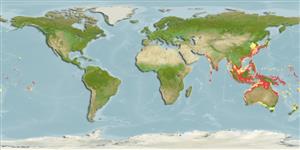Common names from other countries
>
Syngnathiformes (Pipefishes and seahorses) >
Syngnathidae (Pipefishes and seahorses) > Syngnathinae
Etymology: Hippocampus: Greek, ippos = horse + Greek,kampe = curvature (Ref. 45335).
Issue
Junior synonyms Hippocampus dahli Ogilby, 1908 (more studies needed) and H. planifrons Peters, 1877 are considered valid species according to Lourie et al., 2016 (Ref. 115213).
Environment: milieu / climate zone / depth range / distribution range
Écologie
marin récifal; non migrateur; profondeur 0 - 100 m (Ref. 52034), usually ? - 20 m (Ref. 30915). Tropical; 42°N - 42°S, 65°E - 132°W
Indo-West Pacific: India to Tahiti; north to Japan, south to Indonesia.
Length at first maturity / Taille / Poids / Âge
Maturity: Lm 14.0 range ? - ? cm
Max length : 22.0 cm TL mâle / non sexé; (Ref. 48635)
Épines dorsales (Total): 0; Rayons mous dorsaux (Total): 18-22; Épines anales 0; Rayons mous anaux: 4.
Inhabits gravel or sand bottoms around shallow reefs (Ref. 559); muddy estuaries and near mangroves, tolerating brackish waters (Ref. 48635). Occur singly or in pairs (Ref. 128523). Ovoviviparous (Ref. 205). The male carries the eggs in a brood pouch which is found under the tail (Ref. 205).
Male carries the eggs in a brood pouch (Ref. 205).
Lourie, S.A., R.A. Pollom and S.J. Foster, 2016. A global revision of the seahorses Hippocampus Rafinesque 1810 (Actinopterygii: Syngnathiformes): taxonomy and biogeography with recommendations for further research. Zootaxa 4146(1):1-66. (Ref. 115213)
Statut dans la liste rouge de l'IUCN (Ref. 130435)
Menace pour l'homme
Harmless
Utilisations par l'homme
Aquaculture: commercial
Plus d'informations
RéférencesAquacultureProfil d'aquacultureSouchesGénétiqueElectrophoresesHéritabilitéPathologiesTraitementMass conversion
Outils
Articles particuliers
Télécharger en XML
Sources Internet
Estimates based on models
Preferred temperature (Ref.
115969): 24.2 - 29.1, mean 28.3 (based on 622 cells).
Phylogenetic diversity index (Ref.
82804): PD
50 = 0.5000 [Uniqueness, from 0.5 = low to 2.0 = high].
Bayesian length-weight: a=0.00447 (0.00177 - 0.01127), b=3.00 (2.78 - 3.22), in cm Total Length, based on LWR estimates for this (Sub)family-body shape (Ref.
93245).
Niveau trophique (Ref.
69278): 3.8 ±0.50 se; based on food items.
Résilience (Ref.
120179): Haut, temps minimum de doublement de population inférieur à 15 mois (tm=0.5-1).
Fishing Vulnerability (Ref.
59153): Low vulnerability (12 of 100).
